Hi All,
I am working on a comission for a short broad bladed messer of 24" x 2" and am looking for information and period pictures of messer scabbards.
Given the size of the knife/sword I assume that the scabbard was probably all leather with no chape or locket and given the period and origin quite heavily tooled beyond this I am at a loss, but paticularly how it was suspended.
Again I am assuming that the German predispostion for thonging and lashing scabbards will come into it, but particularly how the scabbard is attached to the belt. In addition to this I assume it usually hung vertically.
All in all a bucket of assumptions and little hard fact - any help would dearly be appreciated.
I have also had a good search through the site but my wife is always telling me I couldn't find grass in a field.......
Thanks
Tod
This site will bury you in images of messers, scabbards and anything else you can think of:
http://www.imareal.oeaw.ac.at/realonline/
In the menu box that defaults to "Bildnummern," choose "Materielle objekte"
Put your start date in "Von" box and your close date in the "bis" box (1450 and 1520, for example)
Click the "Auswšhlen" button
On the next page either scroll through the alphabetical list of objects or enter the German term for what you want (messer and kriegsmesser will interest you, but turn up mostly small knives. Try searching for "schwert" because sometimes the large messers are listed that way). Either way, hit the "Zeige Bilder" button when your term is found. You'll get hundreds of images and you have to wait for all of them to load before you view any of them. Otherwise, the page will have to reload when you try to back up.
You'll find a huge variety of sizes, shapes, decoration, by-knives, suspensions, etc.
You should also search for "hl. petrus" under the category "personnenamen". In depictions of the apostles in the garden of Gesthemene (either sleeping or protesting the arrest of Jesus) Peter is almost always depicted with a messer or sword of similar length. The scabbard is sometimes visible, often concealed under Peter's cloak or held in his left hand.
http://www.imareal.oeaw.ac.at/realonline/
In the menu box that defaults to "Bildnummern," choose "Materielle objekte"
Put your start date in "Von" box and your close date in the "bis" box (1450 and 1520, for example)
Click the "Auswšhlen" button
On the next page either scroll through the alphabetical list of objects or enter the German term for what you want (messer and kriegsmesser will interest you, but turn up mostly small knives. Try searching for "schwert" because sometimes the large messers are listed that way). Either way, hit the "Zeige Bilder" button when your term is found. You'll get hundreds of images and you have to wait for all of them to load before you view any of them. Otherwise, the page will have to reload when you try to back up.
You'll find a huge variety of sizes, shapes, decoration, by-knives, suspensions, etc.
You should also search for "hl. petrus" under the category "personnenamen". In depictions of the apostles in the garden of Gesthemene (either sleeping or protesting the arrest of Jesus) Peter is almost always depicted with a messer or sword of similar length. The scabbard is sometimes visible, often concealed under Peter's cloak or held in his left hand.
Last edited by Sean Flynt on Thu 22 Oct, 2009 12:42 pm; edited 1 time in total
Also, this thread includes lots of images of messer scabbards as well as Peter Johnsson's observations on the subject:
http://www.myArmoury.com/talk/viewtopic.php?t...ght=messer
http://www.myArmoury.com/talk/viewtopic.php?t...ght=messer
A sampling:
 Attachment: 204.11 KB
Attachment: 204.11 KB
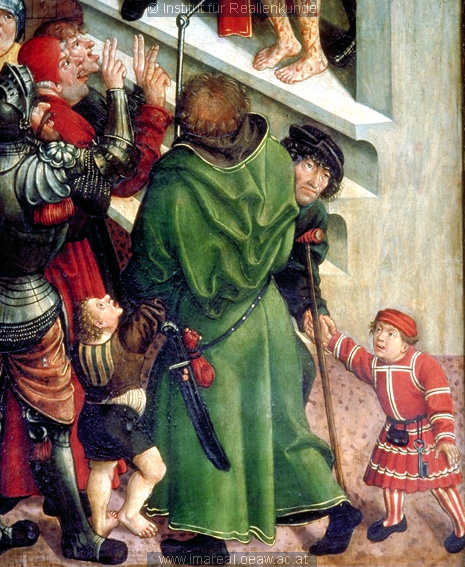
 Attachment: 189.91 KB
Attachment: 189.91 KB
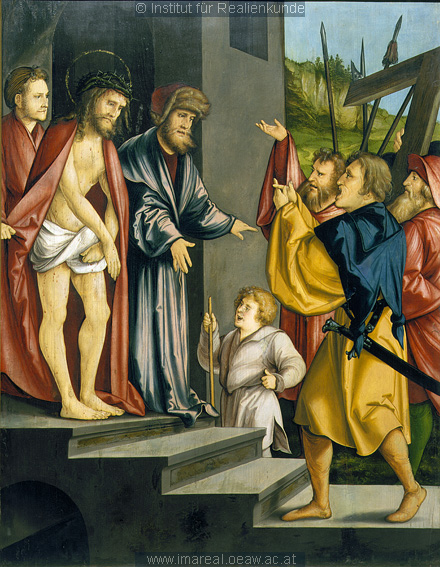
 Attachment: 165.87 KB
Attachment: 165.87 KB
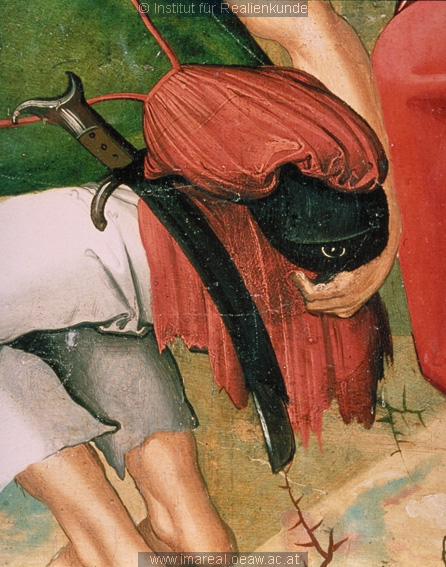
 Attachment: 55.41 KB
Attachment: 55.41 KB
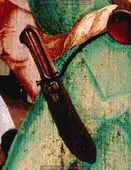
 Attachment: 67.67 KB
Attachment: 67.67 KB
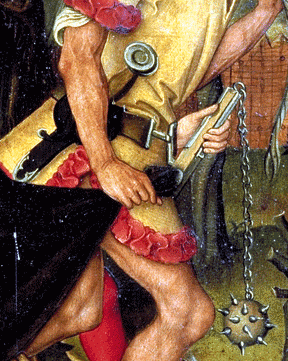
 Attachment: 213.6 KB
Attachment: 213.6 KB
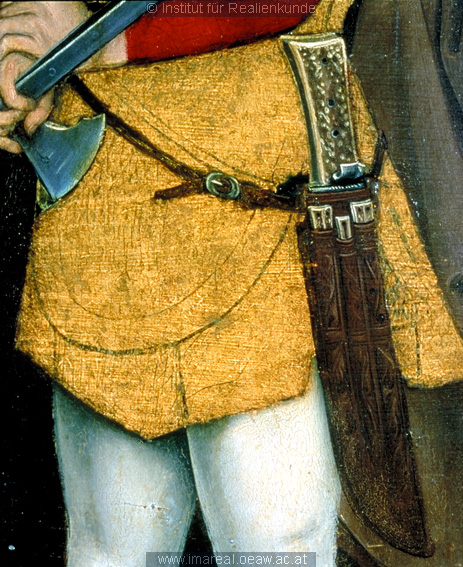






Thanks Sean,
The site is fantastic as is the thread you put me onto there, not sure how I missed that one.
Lots of food for thought - I appreciate it.
I love that last set in the pictures, I came across it a few weeks back and have been thinking about it since.
Tod
The site is fantastic as is the thread you put me onto there, not sure how I missed that one.
Lots of food for thought - I appreciate it.
I love that last set in the pictures, I came across it a few weeks back and have been thinking about it since.
Tod
Sorry for bumping in with OT but
Thank you very much for this , it does indeed look like a very rich source for pictorial evidence
Regards,
Samuel
| Sean Flynt wrote: |
| This site will bury you in images of messers, scabbards and anything else you can think of:
http://www.imareal.oeaw.ac.at/realonline/ |
Thank you very much for this , it does indeed look like a very rich source for pictorial evidence
Regards,
Samuel
I'm attaching an image of a 16th century saber/falchion--a very different type of weapon from what is being discussed here. I wonder if there's any visual cues that can be taken from this and applied to the design of a messer scabbard. The chape is attractive. Any thoughts are welcome.
 Attachment: 50.37 KB
Attachment: 50.37 KB
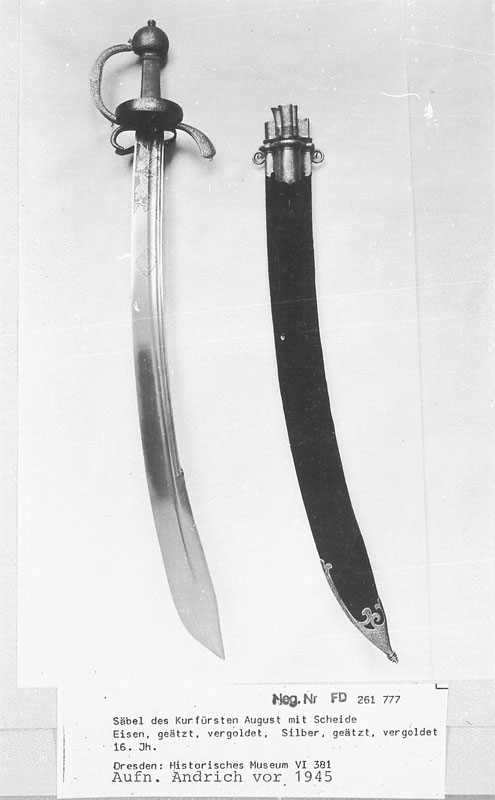
Copyright Dresden Historishes Museum

Copyright Dresden Historishes Museum
More historical artwork attached with descriptions below.
 Attachment: 124.22 KB
Attachment: 124.22 KB
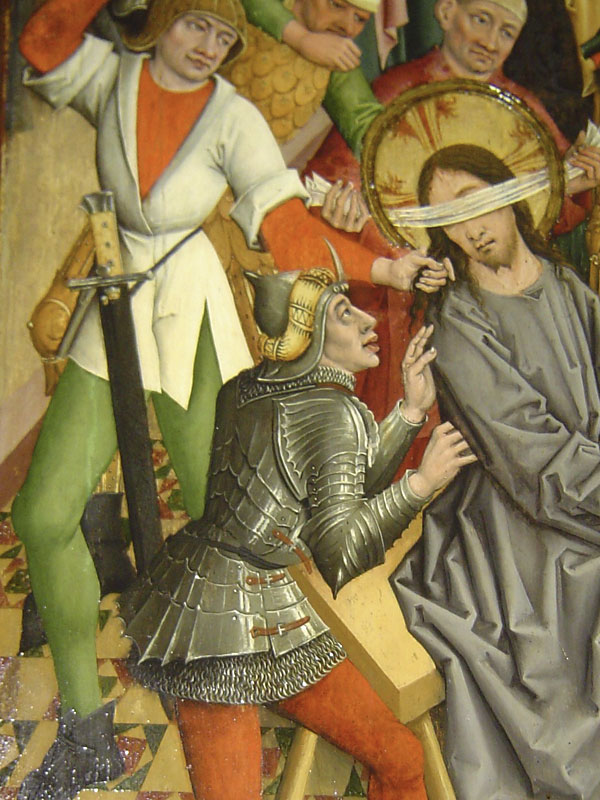
Circa 1480
'Passion of Christ' (Heinrich Lutzelmann), …glise Saint-Pierre-le-Vieux, Strasbourg, France #1
 Attachment: 153.2 KB
Attachment: 153.2 KB
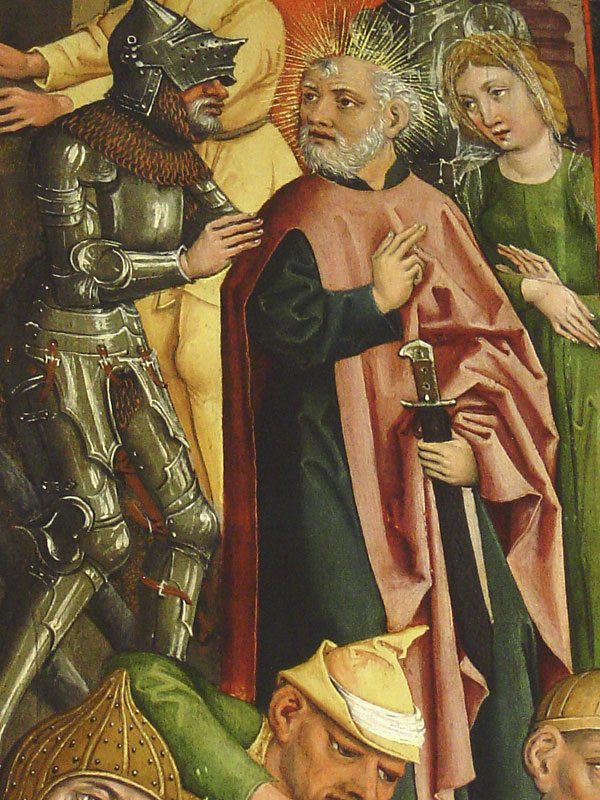
Circa 1480
'Passion of Christ' (Heinrich Lutzelmann), …glise Saint-Pierre-le-Vieux, Strasbourg, France #2
 Attachment: 159.91 KB
Attachment: 159.91 KB

Circa1485
'Crucifixion' (Meister der Ilsung-Madonna), probably Augsburg, Deutsches Historisches Museum, Berlin, Germany

Circa 1480
'Passion of Christ' (Heinrich Lutzelmann), …glise Saint-Pierre-le-Vieux, Strasbourg, France #1

Circa 1480
'Passion of Christ' (Heinrich Lutzelmann), …glise Saint-Pierre-le-Vieux, Strasbourg, France #2

Circa1485
'Crucifixion' (Meister der Ilsung-Madonna), probably Augsburg, Deutsches Historisches Museum, Berlin, Germany
The belt in the first picture does not seem like it would hold on very well.
M.
M.
Unless he has another 2-3 lbs hanging off the other side of the belt, it would tend to sit at an angle like that. Maybe the painter showed it at more of an angle than it should be.
Or, it could be either a double-wrap belt., or hooked to a real belt hidden under the fold of the clothing.
If it's not one of these, you're right, it does look like it would fall off his hips.
Or, it could be either a double-wrap belt., or hooked to a real belt hidden under the fold of the clothing.
If it's not one of these, you're right, it does look like it would fall off his hips.
This pic fascinates me:
[ Linked Image ]
That looks an anwful lot like a snouted bascinet painted circa 1480.
[ Linked Image ]
That looks an anwful lot like a snouted bascinet painted circa 1480.
Could it be because that it's a depiction of a Roman soldier taking part in the capture of Christ? Strongly looks like a derisive image to me...
| Mick Czerep wrote: |
| Could it be because that it's a depiction of a Roman soldier taking part in the capture of Christ? Strongly looks like a derisive image to me... |
Could be, but why the relatively up-to-date rest of the harness with an old-school helm? Seems a strange combination.
| Chad Arnow wrote: | ||
Could be, but why the relatively up-to-date rest of the harness with an old-school helm? Seems a strange combination. |
A) Old armour may still have been in use past their " best before date " ( Joke ) or still used even if we might consider them mismatched to period ? Most paintings of High nobles would only show the best up to date in fashion armour but the common soldier or poorer knights might still use old stuff ! At the very least Mercenaries, local militias might not be overly concerned about " fashionable " kit ?
It's very possible that even a " poor " knight would have to follow the most current fashion or risk being looked down upon though !?
B) The artist painting an out of date helm to show that this is from his perspective something happening far back in the past ?
Works for him and people of his period who probably didn't have a clear idea of what Roman period armour looked like but work less for us as we see it as a helm out of period for Roman times and for the time the painting was done ?
C) Something else I don't have a clue about. ;) :p :lol:
| Jean Thibodeau wrote: |
| A) Old armour may still have been in use past their " best before date " ( Joke ) or still used even if we might consider them mismatched to period ? Most paintings of High nobles would only show the best up to date in fashion armour but the common soldier or poorer knights might still use old stuff ! At the very least Mercenaries, local militias might not be overly concerned about " fashionable " kit ?
It's very possible that even a " poor " knight would have to follow the most current fashion or risk being looked down upon though !? B) The artist painting an out of date helm to show that this is from his perspective something happening far back in the past ? Works for him and people of his period who probably didn't have a clear idea of what Roman period armour looked like but work less for us as we see it as a helm out of period for Roman times and for the time the painting was done ? C) Something else I don't have a clue about. ;) :p :lol: |
If the person could afford a nice gothic harness with embellished tassets, why use a helm that's decades out of date?
If they're trying to portray a time gone by, why combine clearly gothic armour elements with something much older?
I understand what you're saying and have already thought of those angles. :) I still find it strange to see such a late depiction of bascinet with aventail combined with armour of the mid-15th century.
That's actually not a "nice" harness according to German fashion... compare it with the preceding picture, now THAT'S a nice one! :D
On another note, the mail is clearly rusted, and the steel is of a much duller colour compared to the other harness. It gives an overall image of a not-exactly-new harness used by someone not-exactly-rich.
...
Ooops, almost forgot. I don't think that the artist wanted to show that the events happened a long ago, because on the same picture (#1) we have a quite fashionable kit with a few oddities but nothing out-of-date.
That's of course assuming that the two pictures don't have the same names coincidently. :)
On another note, the mail is clearly rusted, and the steel is of a much duller colour compared to the other harness. It gives an overall image of a not-exactly-new harness used by someone not-exactly-rich.
...
Ooops, almost forgot. I don't think that the artist wanted to show that the events happened a long ago, because on the same picture (#1) we have a quite fashionable kit with a few oddities but nothing out-of-date.
That's of course assuming that the two pictures don't have the same names coincidently. :)
Interesting observation about the bascinet. I've always interpreted the guard in GrŁnewald's Isenheim altarpiece as wearing a pig-face bascinet as well, and this work of art was created in around 1512. I've always wondered if the artist was being deliberately archaic or was just depicting something commonly used at the time: old armor.
 Attachment: 60.57 KB
Attachment: 60.57 KB


Memling also shows pig faced bacinets in his paintings of the passion of christ. I am not aware if he uses such helmets in other biblical scenes. Memling was active in the last half of the 15th C (died 1495).
Below is a painting (Passion of the Christ 1470-71) showing the road to Golgata and the crucifixion. Lots of interesting armour here. Leather armour and unusual helmets. One pig faced bacinet in the lower centre of the painting: in a group of soldiers a warrior with a pollaxe on the shoulder walks behind two horsemen.
http://static.artbible.info/large/memling_passie.jpg
And on topic: there are some intersting messer and falchoin scabbards in this painting as well. This painting is a favorite of mine: a multitude of armour styles and soldiers with different status and equipment.
Below is a painting (Passion of the Christ 1470-71) showing the road to Golgata and the crucifixion. Lots of interesting armour here. Leather armour and unusual helmets. One pig faced bacinet in the lower centre of the painting: in a group of soldiers a warrior with a pollaxe on the shoulder walks behind two horsemen.
http://static.artbible.info/large/memling_passie.jpg
And on topic: there are some intersting messer and falchoin scabbards in this painting as well. This painting is a favorite of mine: a multitude of armour styles and soldiers with different status and equipment.
| Chad Arnow wrote: | ||
If the person could afford a nice gothic harness with embellished tassets, why use a helm that's decades out of date? If they're trying to portray a time gone by, why combine clearly gothic armour elements with something much older? I understand what you're saying and have already thought of those angles. :) I still find it strange to see such a late depiction of bascinet with aventail combined with armour of the mid-15th century. |
Maybe that kind of helm has a connotation we've lost in time? Kinda like the Pickelhaube is connotative of the Prussian or German Empires, or the sword connotates authority.
M.
I'd still go with the 'derisive' interpretation - not a representation of antiquity, but using mis-matched elements to visually represent the role of the depicted figure.
Page 1 of 2
You cannot post new topics in this forumYou cannot reply to topics in this forum
You cannot edit your posts in this forum
You cannot delete your posts in this forum
You cannot vote in polls in this forum
You cannot attach files in this forum
You can download files in this forum
All contents © Copyright 2003-2006 myArmoury.com — All rights reserved
Discussion forums powered by phpBB © The phpBB Group
Switch to the Full-featured Version of the forum
Discussion forums powered by phpBB © The phpBB Group
Switch to the Full-featured Version of the forum